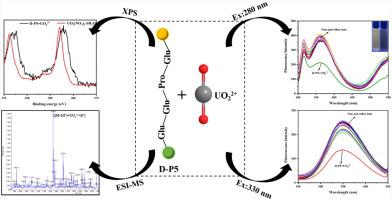Spectrochimica Acta Part A: Molecular and Biomolecular Spectroscopy ( IF 4.3 ) Pub Date : 2023-01-25 , DOI: 10.1016/j.saa.2023.122403
Lianshun Zhang 1 , Mengqing Jia 1 , Xi Wang 1 , Lei Gao 2 , Bo Zhang 1 , Lei Wang 1 , Jinming Kong 3 , Lianzhi Li 1

|
It is of great significance to sensitively and selectively detect uranyl ion (UO22+) in environmental and biological samples due to the high risks of UO22+ to human health. However, such suitable sensors are still scarce. A novel fluorescence sensor based on a dansyl-modified peptide, Dansyl-Glu-Glu-Pro-Glu-Trp-COOH (D-P5), was efficiently synthesized by Fmoc solid phase peptide synthesis. As the first linear peptide-based fluorescence sensor for UO22+, D-P5 exhibited high selectivity and sensitivity to UO22+ over 27 metal ions (UO22+, Cr3+, Cu2+, Ba2+, Hg2+, Pb2+, Co2+, Ag+, Fe3+, Ca2+, K+, Mg2+, Mn2+, Na+, Ni2+, Cd2+, Zn2+, Al3+, Dy3+, Er3+, Gd2+, Ho3+, La3+, Lu3+, Pr3+, Sm3+, Tm3+) by a turn-off fluorescence response in 10 mM HEPES buffer (pH 6.3). The effects of anions such as S2−, NO3–, SO42− CO32–, HCOO–, antioxidant ascorbic acid and 4-nitrophenyl acetate on the selectivity for UO22+ detection were also studies. D-P5 sensor could be used for detecting UO22+ in a good linear relationship with concentration in the range of 0–8.0 μM with a low limit of detection of 83.2 nM. Furthermore, the interaction of the sensor with UO22+ was characterized by ESI-MS, IR, XPS and ITC measurements. The 1:1 binding stoichiometry between the sensor and UO22+ was measured by the job’s plot and further verified by ESI-MS. The binding constant of the sensor with UO22+ was calculated to be 9.8 × 104 M−1 by modified Benesi-Hildebrand equation. ITC results showed that theΔHθ andΔSθ for the interaction of D-P5 with UO22+ were −(7.167 ± 1.25) kJ·mol−1 and 66.5 J·mol−1·K−1, respectively. Time-resolved fluorescence spectroscopy indicated that the mechanism of fluorescence quenching of D-P5 by UO22+ ion was static quenching process. In addition, this sensor displayed a good practicality for UO22+ detection in lake water sample without tedious sample pretreatment.
中文翻译:

基于丹磺酰修饰肽的铀酰离子检测新型荧光传感器
由于UO 2 2+对人体健康的高风险,灵敏、选择性地检测环境和生物样品中的铀酰离子(UO 2 2+ )具有重要意义。然而,这样合适的传感器仍然很少。通过 Fmoc 固相肽合成,高效合成了一种基于丹酰修饰肽 Dansyl-Glu-Glu-Pro-Glu-Trp-COOH (D-P5) 的新型荧光传感器。作为第一个基于线性肽的 UO 2 2+荧光传感器,D-P5 对 UO 2 2+超过 27 种金属离子(UO 2 2+、Cr 3+、Cu 2+、Ba 2+、汞2+ , Pb 2+ , Co 2+ , Ag + , Fe 3+ , Ca 2+ , K + , Mg 2+ , Mn 2+ , Na + , Ni 2+ , Cd 2+ , Zn 2+ , Al 3 + , Dy 3+ , Er 3+ , Gd 2+ , Ho 3+ , La 3+ , Lu 3+ , Pr 3+ , Sm 3+ , Tm 3+ ) 通过在 10 mM HEPES 缓冲液中的关闭荧光响应(pH 值 6.3)。S 2−等阴离子的作用, NO 3 – , SO 4 2− CO 3 2– , HCOO – , 抗氧化剂抗坏血酸和乙酸4-硝基苯酯对UO 2 2+检测选择性的影响也进行了研究。D-P5传感器可用于检测UO 2 2+,浓度在0-8.0 μM范围内呈良好的线性关系,检测下限为83.2 nM。此外,传感器与 UO 2 2+的相互作用通过 ESI-MS、IR、XPS 和 ITC 测量来表征。传感器与UO 2 2+的1:1结合化学计量由工作图测量并由 ESI-MS 进一步验证。传感器与UO 2 2+的结合常数通过修正的Benesi-Hildebrand 方程计算为9.8 × 10 4 M −1 。ITC 结果表明, D-P5 与UO 2 2+相互作用的ΔH θ和ΔS θ分别为-(7.167 ± 1.25) kJ·mol -1和66.5 J·mol -1 ·K -1。时间分辨荧光光谱表明UO 2 2+对D-P5荧光猝灭的机理离子呈静电淬火过程。此外,该传感器在无需繁琐的样品预处理的情况下,对湖水样品中的UO 2 2+检测显示出良好的实用性。

































 京公网安备 11010802027423号
京公网安备 11010802027423号